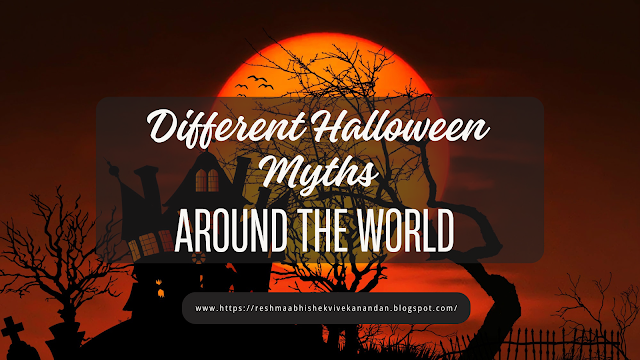Different Halloween Myths Around the World
Halloween, a holiday known for its spooky traditions, costumes, and trick-or-treating, is celebrated in various ways across the globe. However, beyond the costumes and candy, Halloween is rooted in a long history of myths, folklore, and superstitions that differ from country to country. Let’s explore some of the most intriguing Halloween myths around the world.
Ireland: The Origins of Halloween and the Legend of Jack O' Lantern
Halloween, or Samhain, originated in Ireland, and many of the traditions celebrated today have ancient roots in Irish mythology. Samhain marked the end of the harvest season and the start of winter, a time when it was believed that the veil between the living and the dead was at its thinnest.
One of the most famous Halloween myths from Ireland is the story of Jack O' Lantern. Jack was a crafty man who tricked the devil multiple times, eventually leading to his curse of wandering the Earth with only a carved-out turnip lantern to light his way. This myth inspired the modern tradition of carving pumpkins.
Mexico: The Day of the Dead and La Llorona
In Mexico, Halloween blends with Día de los Muertos (Day of the Dead), a celebration to honor deceased loved ones. Contrary to the spooky elements of Halloween, Día de los Muertos is more of a joyous occasion. However, Mexican folklore is rich with chilling tales like that of La Llorona, the Weeping Woman. According to legend, La Llorona is the spirit of a woman who drowned her children and now wanders rivers and lakes in eternal grief, searching for them. Those who hear her cries are said to be marked for death.
Scotland: The Witches of All Hallows' Eve
In Scotland, Halloween was also tied to ancient Celtic traditions. One of the most enduring myths involves witches. According to Scottish folklore, witches were believed to gather on All Hallows' Eve to cast spells and perform dark rituals. It was thought that they could curse anyone they wished or even transform into animals to cause mischief. To protect themselves, people carved turnips and placed them in windows or by doorways to ward off evil spirits.
Japan: Obon and the Myth of Goryō
Japan does not traditionally celebrate Halloween, but it has its own ghostly festival called Obon. This Buddhist event, held in August, honors the spirits of ancestors who are believed to return to the world of the living during this time. One haunting myth associated with Japanese Halloween-like traditions is the legend of Goryō, vengeful spirits of those who died in suffering or disgrace. These spirits were believed to haunt the living, seeking revenge for their wrongful deaths, and needed rituals to pacify them.
Germany: The Belief in Evil Spirits and Knocking Ghosts
In Germany, a traditional Halloween myth involves hiding knives during the holiday. Germans believe that on Halloween night, spirits of the dead roam freely, and any sharp objects like knives or scissors must be hidden to prevent them from harming the living. There's also the myth of knocking ghosts, where it is believed that mischievous spirits knock on doors, playing tricks on the household if not appeased.
Italy: The Feast of Lemuria and the Hungry Dead
Halloween may not have originated in Italy, but ancient Romans had a festival known as Lemuria, which occurred in May. During Lemuria, Romans would perform rituals to appease the Lemures, or restless spirits of the dead who wandered the Earth. To ward off these malevolent ghosts, Romans would offer beans to the spirits to calm them and keep them from haunting the living. While Lemuria was celebrated long ago, its myths still echo through some of Italy's modern Halloween practices.
China: The Hungry Ghost Festival
In Chinese culture, Halloween-like traditions are observed during the Hungry Ghost Festival, celebrated in the seventh lunar month. According to legend, the gates of the afterlife open, and hungry spirits come back to the land of the living. These ghosts, often seen as forgotten souls without descendants to care for them, wander in search of food and offerings. The Chinese burn incense, offer food, and even perform elaborate operas to please these spirits and keep them at peace.
Romania: The Legend of Dracula
Romania is deeply tied to the Dracula legend, based on the historical figure Vlad the Impaler, who inspired Bram Stoker’s famous novel. Dracula, a blood-thirsty vampire, became a symbol of the country’s eerie folklore. In Romanian Halloween traditions, it is believed that the spirits of the dead, including vampires, walk the Earth on this night. To keep these spirits at bay, people leave garlic outside their doors or windows.
The United States: Ghosts and Black Cats
American Halloween is filled with myths and superstitions, many of which have European origins. One common belief is that seeing a black cat on Halloween is a sign of bad luck, as these animals are often associated with witches. Additionally, the ghosts that appear on Halloween are said to be the spirits of the departed returning to the world of the living. To avoid encounters with these wandering souls, people wear costumes to blend in and confuse them.
Halloween myths vary greatly across the world, from the wandering souls of Mexico’s Día de los Muertos to the witches of Scotland and the hungry ghosts of China. While some traditions are meant to honor the dead, others focus on warding off evil spirits. Regardless of the location or origin, these myths add a rich layer of mystery and fascination to Halloween, making it a truly global celebration of the supernatural.



Comments
Post a Comment